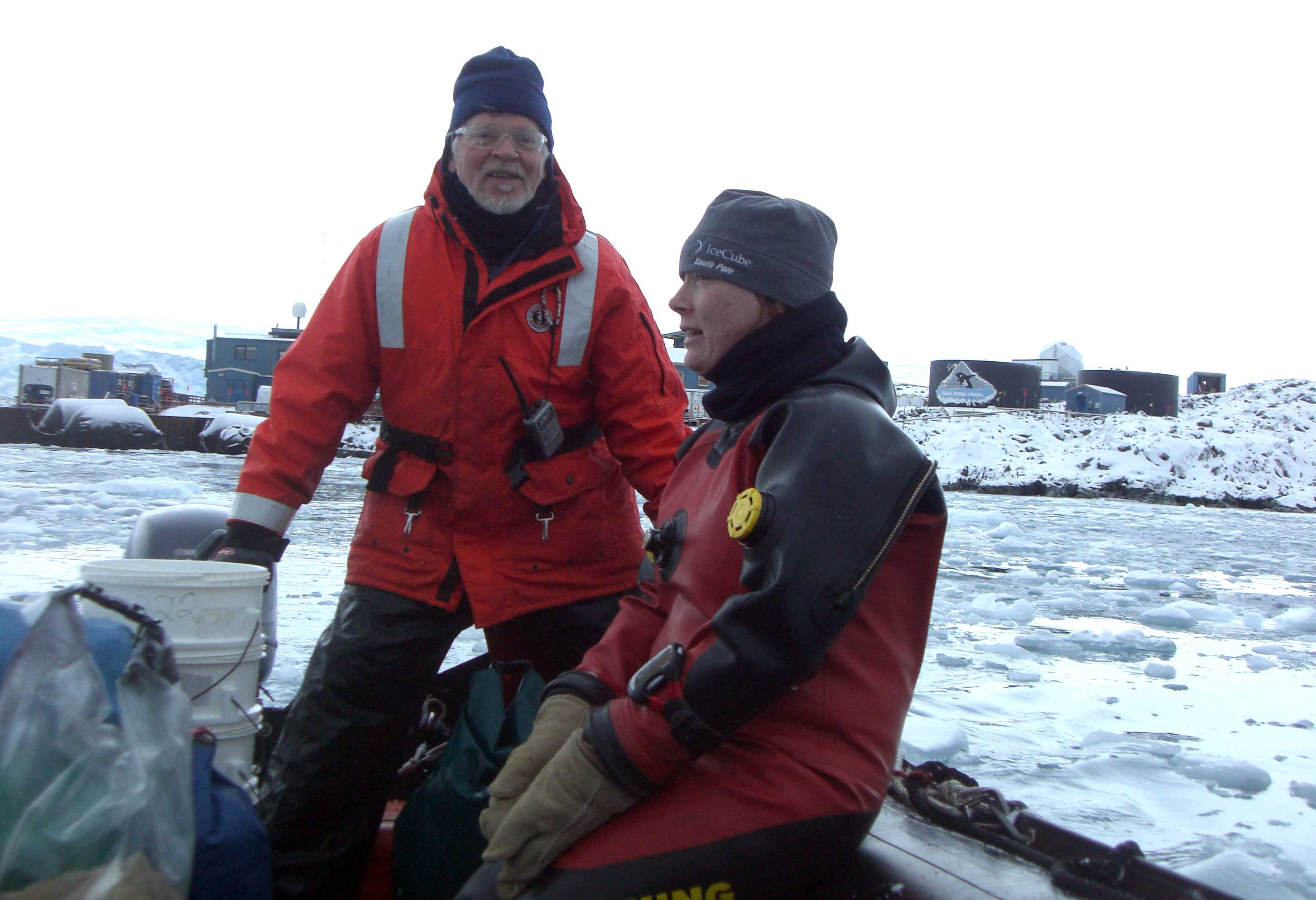
As Chuck hinted in Dive Ops, part 1 this entry will focus on the tender side of our diving operation. Tender, in our vernacular, is used as a noun and refers to the act of tending to one's needs – in this case – a diver's needs. All of our dive operations have two divers and two tenders. Every project member routinely serves as a tender and often a volunteer or 'town tender' substitutes for one of us so that member can remain on station to instead tend to lab work. The other day I served as project tender and had the delightful assistance from town tender Harry Snyder, the winter-over carpenter. In addition to extraordinary wood working skills, Harry jams smiling at ease on the guitar and at the throttle of a zodiac as pictured.
Standard procedure before leaving the station proper (either on foot or by zodiac) is to sign out on a big black chalk in the main hallway. Required information is names of folks, destination, departure and estimated return time and name of group. Chuck tended to that duty scribbling in white chalk: "Julie, Harry, Maggie, Chuck"; "Litchfield Is, DeLaca Is, Bonaparte Pt"; 9:30 am; 12:30 pm; Divers". Hmmm, a three hour island tour sounds oddly familiar.....
Since Harry was at the tiller and though also carrying a required radio his hands were busy so I radioed in to station that the "Divers" were departing for Litchfield. Yuki, the comms tech responded, acknowledging our departure time. He would continue monitoring our radio updates to acknowledge and track our whereabouts. As you can see in the image of tender/captain Harry and diver Julie, there was some brash ice on the harbor waters that slowed our transit but slowly bumping and dodging ice allows some social time and photography opportunities before throttling up the engine once in ice free water. It is also a good time to get a better sense of the winds being away from sheltering structures of station buildings. Wow- after days of high winds, barely a breath of breeze puffed at us. In fact when we reached Litchfield about 10 minutes later the dive site was windless and waters flat calm. My kind of tending!
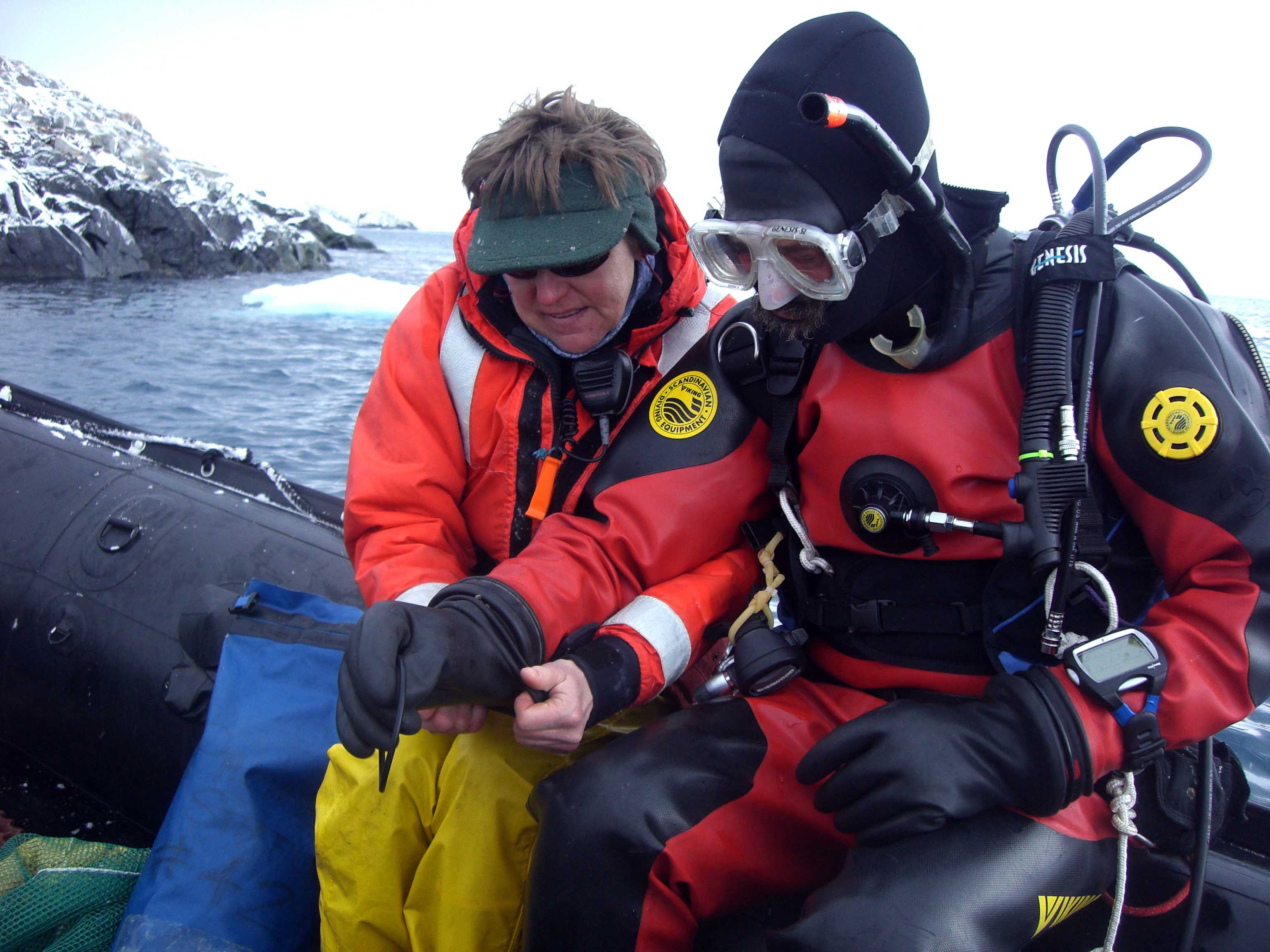
Harry remained at the tiller as we floated, the gear shift in neutral, at the dive site and I tended to helping Julie and Chuck get into their shoulder-harnessed weight belt followed by tank for each. I spared Harry the joy of gloving the divers – stretching the heavy rubber lineman's glove up and over the hard wrist cuff of the diver's drysuit and securing it with a taut fat o-ring. The combination ensured the 5-fingered wool mitt encasing fingers would stay dry and somewhat warm/dexterous. Harry snapped an image of Chuck being gloved at left.
I took over on the tiller to put the divers in the water. Splash, splash went Julie and Chuck. A radio call to station updated "two divers in the water". Harry and I then watched bubbles indicating the location of the submerged pair. See the bubbles in image right, by Harry's elbow? In the meantime Harry took a quick photo and I noticed the wind had freshened – hmm. I remained at the tiller and picked up the divers a short ten minutes later. Another call to station "two divers out of the water" was followed by filling a bucket with seawater to keep the diver collected sampled critters happy. Harry took over at the tiller as I radioed our departure to station. Next stop DeLaca Island. As we cleared the high reaching spans of Litchfield it was evident the wind had picked up. Hmm... a three hour tour, the weather started getting rough....Harry pressed on through a deepening swell.
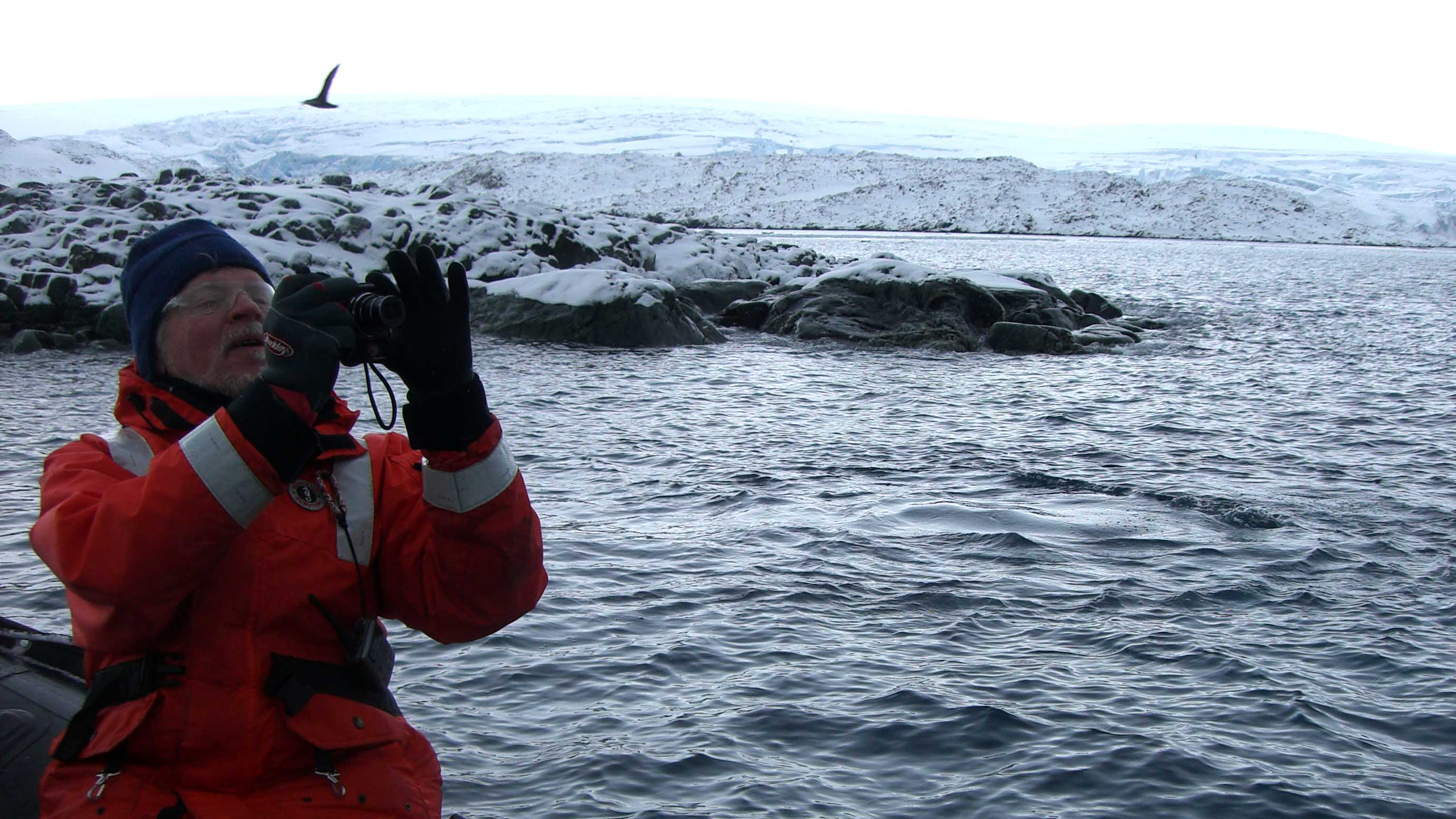
"Palmer Station Divers have arrived at DeLaca" I announced as Harry completed the survey of the area and we determined where next to take a quick plunge for the second island sample. Second dives are always more challenging for divers and tenders. When doing multiple dives, divers only remove tank and weight belt in order to get back into the zodiac. Gloves, mask and fins stay on. So getting divers back into shoulder-harnessed weight belt and tank while standing in fins three times the length of normal shoe size and wearing mask which severely limits peripheral and down-facing vision is a challenge for all. I spared Harry that fun too and danced about Julie and Chuck one at a time to get them re-geared. And then "Palmer Station two divers in the water at DeLaca".
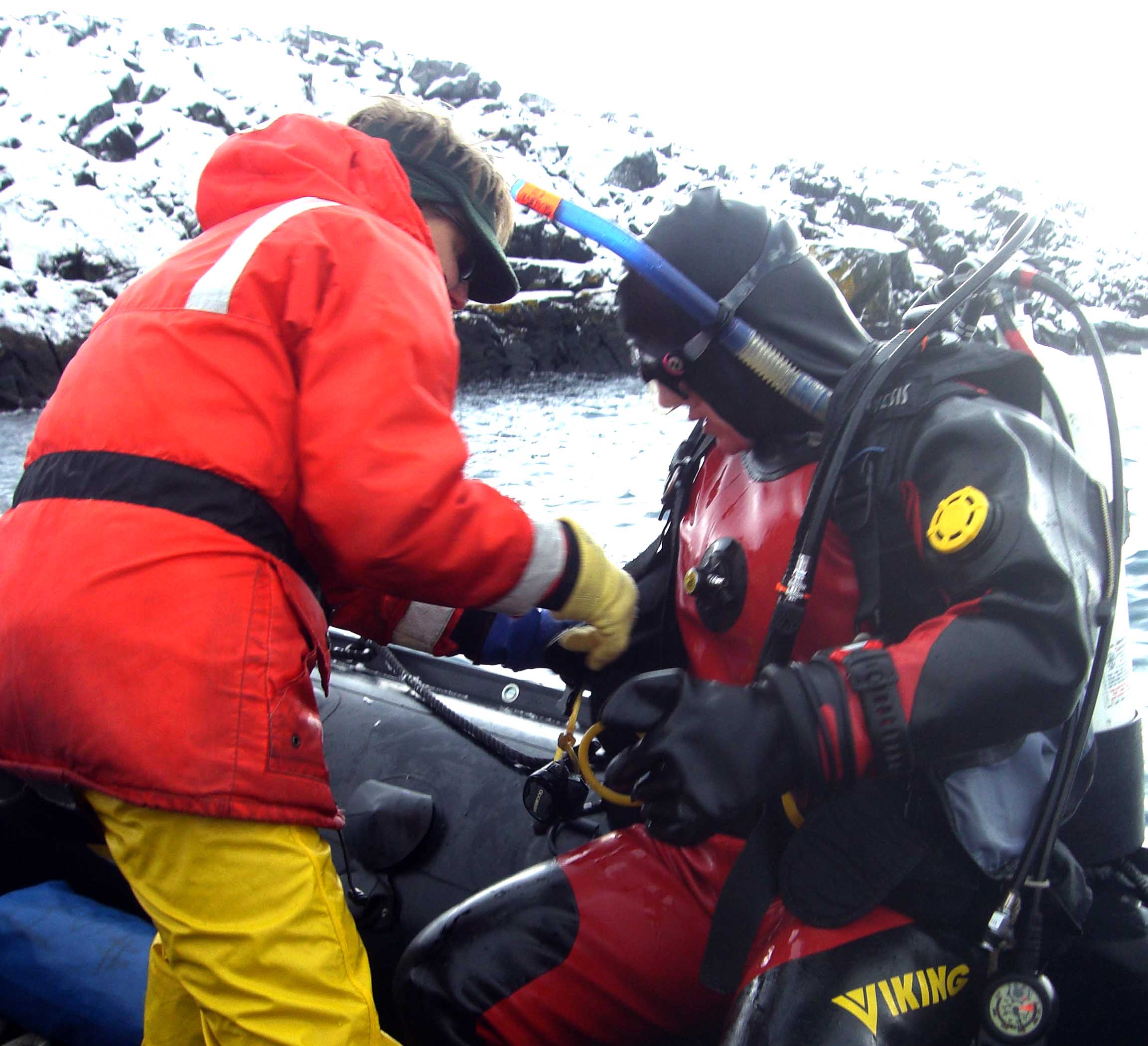
Again, at the tiller, the zodiac was harder to keep in place. The wind had freshened yet again. Shortly thereafter the radio calls "Divers, Divers, this is Palmer Station - be advised the winds are gusting 24 knots". It is not legal/safe to be out in the zodiac when the sustained wind speed is over 25 knots. "Divers about to surface" was our reply and once they surfaced I aimed the bow between their hooded heads for a more difficult than usual pickup given the increased wind. "Palmer Station, two divers out of the water". While we dealt with getting the collection into a bucket of water we rechecked the weather. Wind was not quite over the limit yet so we decided "Palmer Station departing DeLaca for an alternate location of Hero Inlet" closer to station and should be wind protected from the direction of the wind. Hmmm.... A three hour tour, the weather started getting rough, the tiny ship was tossed....
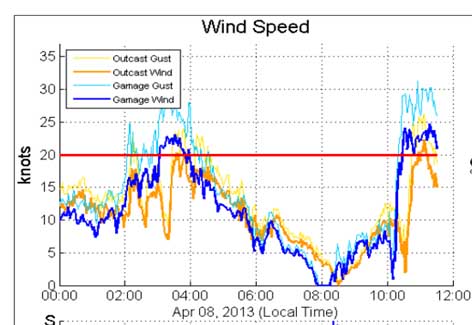
As Harry motored us in the direction of station and adjacent Hero Inlet it was obviously windier and seas lumpier than regular boating allowed. Another check of the weather verified sustained winds were now above the legal limit. (See the graph right that shows the abrupt change in wind speed during our morning out. The red horizontal line is the boating limit.) For an experiment Julie will write next about, a third collection was vital. The two sites alone would not tend to the needs of the experiment. A third collection had to be done. So – diving from shore is not wind limited like diving from the boat. "Palmer Station, divers are returning to station, will tie zodiac up to floating dock and divers will dive from boat". Technically, we were no longer boating so all was cricket. "Palmer Station two divers in the water". Ten minutes later "Palmer Station two divers out of the water".
Not quite a three island tour, but gratefully not more than a three hour tour much less a stranding on Gilligan's Isle polar style. Anything goes when tending but has always included a safe return to Palmer Station! For a less weather-impacted tender view check out this video made in a previous season :
http://www.youtube.com/watch?v=5ajlPF1qOqo